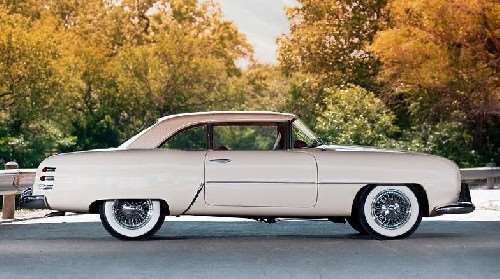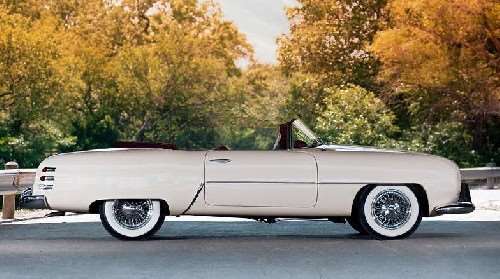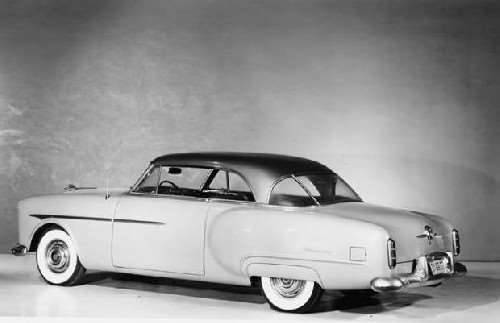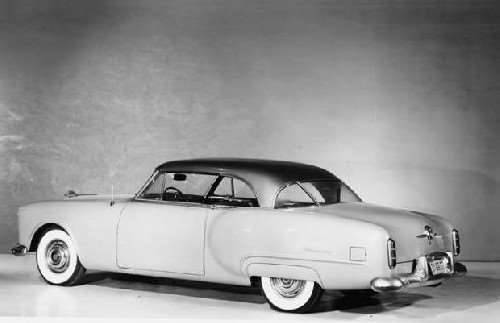|
Re: SP merger
|
||||
|---|---|---|---|---|
|
Home away from home

|
Bringing Studebaker back into the conversation, sales of their '53 Loewy coupes might have given P-H some cause to consider a GT series. The logic would have been that the tall Jet sedan cost too much for what it could fetch, at least in the U.S. market, but a hot coupe of same material cost could sell for hundreds more. The new for '56 cars could have been paid for by the profits from the large '55s or, were the investors game, rushed for '55, Hudson body engineers putting to good use the army of Packard body folks now punching in at Jefferson Ave.
Here's an Italia clean-up in 2+2 coupe and convertible form that works in cues from this thread's large Hudson proposal. Am thinking maybe hidden headlights. Price would have been around $2,500. Volume, not sure but even if it was not much more than the '53-54 Jet the per unit profit would have been much higher, giving them a chance at profitability. So this would have been Hudson's special play. For Packard, maybe a limo series based on its large new '55 sedan.
Posted on: 2015/4/4 14:46
|
|||
|
||||
|
Re: SP merger
|
||||
|---|---|---|---|---|
|
Home away from home

|
From this thread, or possibly a different one, I got the idea that Packard's management planned to increase production and revamped their factories in the late forties to give them the capacity to make 200,000 cars per year.
But, they never followed up. Whether they tried to increase sales but nobody wanted that many Packards, or what happened I don't know. I do know by this time they were concentrating on medium price cars (Clippers) and neglecting the senior models, thereby handing the luxury car market to Cadillac on a silver plate. Speaking of new models I wonder if it would have been possible to put the Studebaker hardtop body on a Packard Clipper frame, and build a Panther personal luxury car to compete with the Lincoln Continental Mark II?
Posted on: 2015/4/4 15:24
|
|||
|
||||
|
Re: SP merger
|
||||
|---|---|---|---|---|
|
Home away from home

|
Happy Easter everyone.
Intersting idea Rusty. Packard's body was around 4 inches wider than Studebaker's so certain stampings such as roof, decklid and hood would not have been wide enough but doors, front fenders and rear quarters might have fit. Or Packard could have sectioned their own hardtop the way Henney did the Pan American. I recently did a sectioning of sorts to the Mayfair to see what would result; toggle between both images to see the progression. The Continental-type car you mention might have benefitted from a beltline kick-up such as shown, and minimized the rework in process. Always thought Packard missed an opportunity when it bought Conner... instead of moving final assembly in it could have used the space to set up a custom body shop that would rework select stampings and feed the new panels back onto the regular production line. Heard same thing about the 200K capacity, impression is that they set up two production lines. Have no knowledge of what became of it.
Posted on: 2015/4/5 14:18
|
|||
|
||||
|
Re: SP merger
|
||||
|---|---|---|---|---|
|
Home away from home

|
Hi Paul
"Wonder if it was also a case of the engineers not being given clear direction early enough on what size the engine needed to be." From what Mr. Neal wrote, considerable indecision persisted with the engine sizes and production timing. The first references to the V8 were in August 1950 on the progress made, that both 269 and 309 ci units were under development. By November 1950, Graves recommended that a single 327 ci V8 could fulfill all their requirements, variation for model applications to be by axle ratios (perhaps compression and carburetion as well). Discussions continued as to whether the engine could be ready for 1953 production in the 26th Series. Estimated tooling and manufacture costs of $18M ($4-5M was included for body changes) versus sales for the remaining 1951 model run and projected 1952 25th Series, curtailed because of Korean War Government quotas, caused them to delay until profits could better absorb the cost. Quite a conundrum: more sales were needed to finance the V8 but present sales were being hamped by external restrictions and the very lack of a V8 in the first place. Your projections for what should have been their 1955 sales results seem plausible if P-H had been able to collaborate and produce compelling all-new cars. The secret word is 'compelling' (You Bet Your Life). That could easily describe the 1948 Step-Down Hudson; long, sleek and best of all, nearly eight inches lower yet with the interior room expected. Hudson really took the lead in packaging heights for sedans, only the Studebaker came close, then Kaiser a few years later. By the advent of the Jet, how management thinking had changed, the opposite of what one would think would have been, perhaps 54"-56" high. Frank Spring should have fought Barit tooth and nail to prevent the design that happened. Goes to show.....never show your worst work hoping it will snap management back to its senses. The trend toward lower cars began in the 1930's with the Cord's dramatic demonstration what was possible. Cadillac picked it up with the '38 60 Special showing it could be done albeit with rear wheel drive. Harley Earl's Y-Job and the Chrysler Thunderbolt teased the pre-war public but in each case were convertibles and not considered 'mainstream'. Oddly enough, though lowered sedans weren't thought appropriate for the general public, for 1940-41 a series of 60 Special Executive Customs were built by Fleetwood for top GM brass, many of which had tops lowered 2"-3" inches. Earl and GM should have been the natural leaders to create cars in the 58"-60" tall range by 1948, not the 63.5" of the new C-Bodies that appeared. Postwar customizers were leading the way, using sectioning to achieve the proportions that should have been a clue for any savvy management to emulate. The only way for any carmaker to consistently clear its break-even point and stay profitable is to consistently present desirable, compelling cars of consistently high quality for their price segment. At lot of 'consistency', isn't it. Production levels, however much internal planning required, still ultimately have to be adjusted to customer demand. Reading Mr. Neal's 1948-1950 text, one is struck by how focused Christopher was on series production at levels projected to be profitable regardless of whether the cars were desirable and compelling enough to create demand that would support his assumptions. The massively costly clean-up of leftover 22nd Series cars discounted heavily showed that even the production wizard couldn't overcome customer resistance to cars founding wanting by the public. Old George left Packard never recognizing that the 120's he shepherded to high production were desirable, compelling cars and the public responded....but his last production push wasn't for cars perceived as well as the erstwhile 120. Nor did his successors grasp that the intangible 'compelling' factors that make or break a car needed far more attention than it was receiving. As Paul has developed arguments for, Hudson was a better prospect for sharing new car development efforts for 1955. Their need was long overdue and coming into alignment with Packard's as well. Nash was a segment too far below, their new 1952 Airflyles not due for renewal on Packard's schedule. Studebaker was worse and beset with myriad self-inflicted troubles no other carmaker could hope to rectify. Hudson had the magic ace-in-the-hole in their Step-Down lowered configuration. The new cars would require internal structures to facilitate frequent restyles to keep up. With this in place, both makes could have presented compelling cars that drove high demand; the production/break-even/profitability picture would have taken care of itself. Steve
Posted on: 2015/4/5 15:02
|
|||
|
.....epigram time.....
Proud 1953 Clipper Deluxe owner. Thinking about my next Packard, want a Clipper Deluxe Eight, manual shift with overdrive. |
||||
|
||||
|
Re: SP merger
|
||||
|---|---|---|---|---|
|
Home away from home

|
I was aware of the difference in width and wheelbase of Packard vs Studebaker. To widen the Studebaker body would cost too much.
My idea was to make up the difference in the fenders which had to be changed anyway. We are talking about 2" on each side. Notice how the Packard's rear fenders bulge out while the Studebaker tapers in at the rear. Making Packard style fenders and using production Packard tail lights would give the required width. For the front, the fenders would have fully cut out wheel wells with flares, sports car style. With Packard headlights and grille. It might have been better to make wider fenders with a scoop effect at the back as seen on some sports cars like the Corvette and Curtis 500. It would also have been necessary to make new door skins without the distinctive crease. Studebaker did this later anyway. For a sport model, interior room would have to be sacrificed in the interest of style, both height and width. Comparing the specs of the Clipper chassis which has the same wheelbase as the Lincoln Continental, and the Studebaker body I believe it would have been possible to make a low production "halo" car to compete with Continental, Eldorado,Chrysler 300, and Jaguar. Whether it would have sold in sufficient numbers to make a profit is another question.
Posted on: 2015/4/6 15:23
|
|||
|
||||
|
Re: SP merger
|
||||
|---|---|---|---|---|
|
Home away from home

|
From what Mr. Neal wrote, considerable indecision persisted with the engine sizes and production timing. The first references to the V8 were in August 1950 on the progress made, that both 269 and 309 ci units were under development. By November 1950, Graves recommended that a single 327 ci V8 could fulfill all their requirements,
iirc, some weeks ago, you mentioned that the new Neal book talks about the decision to close the foundry. so....what's the story? Not enough volume to keep it running? The company didn't want to invest in it to keep it efficient? Using Lakey was cheaper? Trivia bit: I noticed among the marine engines on display at PPG, one of the flatheads has the Lakey foundry mark on the head, while the flathead next to it does not.
Posted on: 2015/4/7 15:50
|
|||
|
||||
|
Re: SP merger
|
||||
|---|---|---|---|---|
|
Home away from home

|
My idea was to make up the difference in the fenders which had to be changed anyway. We are talking about 2" on each side. Notice how the Packard's rear fenders bulge out while the Studebaker tapers in at the rear. Making Packard style fenders and using production Packard tail lights would give the required width.
By the mid 50s, Studebakers were noticeably narrower inside, than other low priced cars. A narrow Studebaker interior would be even more unacceptable in a luxury car, even if the outside was puffed up to make the car look wider.
Posted on: 2015/4/7 15:53
|
|||
|
||||
|
Re: SP merger
|
||||
|---|---|---|---|---|
|
Home away from home

|
"The only way for any carmaker to consistently clear its break-even point and stay profitable is to consistently present desirable, compelling cars of consistently high quality for their price segment."
Steve - you summed it up nicely. Packard was run as too many car companies are today, by play-it-safers who have no compelling product vision. Here's a good video on Packard. At around 41:30 the late Bob Turnquist explains Nance's mistake: in 1954 he had the bankers on his side, then he squandered their money. In one of the history books it says his plan was to lose money in '55 and '56 then turn a profit in '57 with the new cars. What kind of cockamamie plan was that? 1955 was the year to go all in and get rich or go broke. https://www.youtube.com/watch?v=hMw1c_Ol2sQ Rusty, I like your creative thinking and agree it would have been wonderful for Packard to have fielded a Continental competitor. Like Steve203, I think the risk would have been a too narrow interior. Also, the Conti had its cowl belly frame; i.e., step-down. Packard's taller floor would have been the Darrin Victoria all over again, a beautiful car that generated buzz but might have reminded people that the production cars were too tall. Just remembered something else mentioned in the Hudson Chrestline book. Mason was not happy when Nance did not reciprocate and buy stampings from Jefferson Ave. after AMC committed to buying V8s. Mason thought the contract stipulated reciprocity but after his team carefully read it they learned that it did not. Nance may have thought he and his "key men" had duped a fellow car CEO but history showed them to be the real losers. Soon after Mason passed, Romney discovered that in October 1954 Nance acquired an option on the Murray facilities. Once Romney learned this he knew there would be no reciprocity and ordered his engineers to quickly ready a V8. Eighteen months later it was in production and Packard's V8 order was cancelled.
Posted on: 2015/4/7 17:28
|
|||
|
||||
|
Re: SP merger
|
||||
|---|---|---|---|---|
|
Home away from home

|
Hi
Spoiler alert to anyone reading Mr. Neal's 1951-1954 book not to read this next paragraph if you want to learn about the foundry problem as you read. Steve203: Mr. Neal wrote about the Executive Committee discussions of the foundry problems during early months of 1953 in relation to planning the V8 production. Although $200K had been spent to refurbish it in the late 1940's, Nance had been receiving reports of high turnover and low efficiency from his arrival. By spring 1953 foundry inefficiencies were costing $100K a month. Options were to renovate it over a year-long project to the cost of $400K or replace it with a totally new facility at $10M. Apparently the situation had deteriorated to the point where they gave up, decided to source casting outside, declared it surplus and put it up for sale by September 1954. Rusty: A halo car would have been great for their image, though recycling any use of Studebaker panels built on the Contour chassis would probably have been more costly and gained less bang-for-the-buck that creating an all-new car based on a step-down engineered chassis. The Continental Mark II development that ran concurrent to the Pan Americans, Balboa X, Panther Daytonas and Request started not only as a fresh design but also a completely new low 'cow-belly' chassis, essentially a ladder-perimeter combination, not shared with production Lincolns. The problem Paul points out with prior efforts is the combination of tall frame, flat floors and low body profiles results in less-than-satisfactory seating position and legroom. Initially, profitability was never a Mark II project consideration but internal political machination changed that by 1956. Part of the motivation may have been that Ford Motor Company went public and the concept of a major money-pit-ultra-luxury 'vanity' car for the Fords wasn't something conservative investors looked for in a well-managed company. As neat and interesting as the Mark II is, it was an expensive proposition for a company even with the resources that Ford commanded. Packard might well have developed such a car once their merger with Hudson stabilized and a strong market showing put their regular models back in seriously competitive contention again. In the meantime, 1955-57, ultra-luxury versions of production models such as the Caribbean would have to do. What the heck, it worked well enough for Cadillac with the Eldorado Biarritz and Seville. Even Cadillac discovered they couldn't afford to keep their ultra-luxury Broughams going: if GM couldn't do it then, nobody else could. A market awaiting the right car was the personal luxury four-place coupe and convertible segment. Ford figured it out somewhat based on good demographic analysis and just plain dumb luck with the '58 Thunderbird. Both Independents would have benefitted from an ironclad reciprocity agreement. Mason may have been dealing in good faith but whether Nance was is an open question; seem to have inserted enough "ifs" to allow S-P not to. We don't have exact figures but S-P probably sold more dollars worth of powertrain units than the value of the parts sourced from AMC. Both companies had unused capacity, both needed efficient production wherever it could be had. Neither seem to understand a flexible give-and-take was better than going it alone. Hubris was fatal for Packard, nearly for Studebaker. It would have been for AMC except that Romney made gutsy decisions which allowed it to step slippery stone-to-slippery stone across the competitive creek to a prosperous solid ground. Steve
Posted on: 2015/4/9 18:18
|
|||
|
.....epigram time.....
Proud 1953 Clipper Deluxe owner. Thinking about my next Packard, want a Clipper Deluxe Eight, manual shift with overdrive. |
||||
|
||||

 (66.66 KB)
(66.66 KB)









